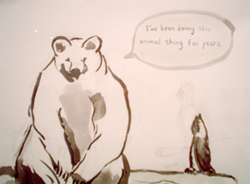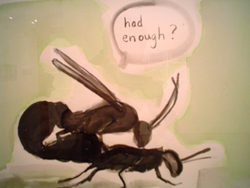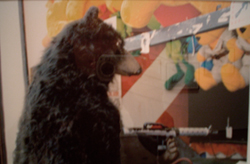
|
||
|
Portland art blog + news + exhibition reviews + galleries + contemporary northwest art
|
||
Malia Jensen at Elizabeth Leach (part 1) Malia Jensen's drawings offer the same conundrum as New Yorker cartoons. Are they funny? Am I missing something? Is the humor over my head?
Like New Yorker cartoons, Jensen's drawings offer multiple possibilities for interpretation and leave the viewer floundering in the space between language and image, trying lamely to connect the two, unsure whether to laugh or not. Jensen's cartoons are drawn with a light, casual touch, nonchalantly dismissive of notions of formal mastery in the medium of drawing. They emulate the accessibility of sunday comics or greeting cards. Jensen appropriates commercial forms that democratize high art practice by producing skill-less renderings which deflate the elitism of the medium. Having set up an innocuous, democratic field in which to operate, Jensen proceeds to throw metaphysical fire-bombs. We look to the word balloon for justification of the hasty drawings. We expect to read a complex yet light-hearted insight which will generate a narrative structure to support the drawing. Instead of insight or witticism, the statements are obvious and dull. They seem to draw attention to the strangeness of our expectations from the familiar form. Somehow we have learned to expect irreverent insight into the difficulties of middle age or modern life from a talking bear. We expect perhaps that the bear will say something about widespread cell-phone use. 
Jensen's talking bear instead says, "I've been doing this animal thing for years," in what seems to be a confessional conversation with an owl. This cartoon contains no joke, merely a self-identification on the part of an animal. This simple statement of self-reference, this simple contemplation of identity, leads to the center of Jensen's work. It is a contemplation of the meaning and location of consciousness. As the bear realizes and confesses that it is in fact an animal, or at least has been acting as an animal for years, the viewer simultaneously understands their own arrogance as they are confronted with the frustration of their expectation of frivolous insight into the petty difficulties of their own lives. Jensen ridicules the self-absorption and narcissism inherent in culture at large. The cartoon bear is a simulation of a real bear, and in Jensen's unfunny cartoons, the real bear speaks through the filter of the simulation. Has there ever been a cartoon which sought to address the bizarre, violent, desperate and magical experience of actually being a bear? Perhaps Daniel Duford's Naked Boy will give us a thorough investigation of bear consciousness. Finally! 
Another of Jensen's cartoons depicts two mating wasps and articulates some of the unpleasant ideas about sexuality constructed through zoological study and best explored in Camille Paglia's book Sexual Personae. Paglia points out that despite our view of the animal world as passive and beautiful and a source for meditation on our own ideas of utopia, sexual brutality is part of the evolutionary adaptation of many species. Jensen's "cartoon" confronts the disparity between our utopian fantasies of the animal world and the actual experience of the animals. Once again, the real wasp speaks through the filter of the cartoon simulation. In the act of copulation the male asks the female, "Had enough?" Jensen does not spare us the consequences of anthropomorphism. If we indulge in fantasies of animals with human personalities, the converse zoomorphic principles must also apply, namely the existentially terrifying possibility that human beings are simply animals with a single superfluously, decadently overdeveloped organ: the brain. The realization slowly emerges that Jensen's non-cartoon essentially depicts a zoomorphic rape scene. In Sexual Personae, Camille Paglia studies the mating practice of that most elegantly symbolic creature, the dolphin. Apparently, mating practice within the pod amounts to the human equivalent of gang rape. 
Jensen returns to the theme of the real communicating through the filter of anthropomorphized simulation in Bear Story, a series of photographs in which someone (the artist?) dressed up in a bear costume enjoys a day at Coney Island. We see the bear riding the subway, playing carnival games, and walking contentedly down the boardwalk. Under different circumstances, performing different activities, the presence of someone in a bear costume would seem delightful and entertaining. As she does in the cartoons, Jensen sabotages the familiar and accessible form. If the simulated bear were in an environment where its presence was announced and functional within some kind of social architecture, like a theme park, we would be able to understand and predict its behavior utterly. For instance, we might identify the simulation as a familiar cartoon character, and run up to have our picture taken with it. However, Jensen has extracted the bear from the larger construct in which the simulation functions. As in the cartoons, the simulation breaks down and becomes conflated with the real. We are suddenly confused and creeped out by the appearance of this character, which has somehow escaped from the simulation construct into the real. Should we identify it by the cartoon personality of the simulation, or have we encountered just a creep in a bear costume? It is interesting that this ambiguity could only really be resolved by a self-identification on the part of the character, a self-referencing declaration of being. In referring back to the cartoon, we imagine the explanation of the person in the costume: "I've been doing this animal thing for years." In the cartoon this phrase seems to be an incursion of the real into the simulation. In the series of photographs however, because of the accepted verite nature of the medium, this phrase is an incursion of the simulation into the real. The bear in the cartoon is saying that he is a real bear, not a cartoon. The same explanation offered by the person in the bear costume is a self-identification of simulation. The meaning becomes: "I am just putting on an act. Don't be afraid, this is only a simulation." (to be continued...) Malia Jensen • Nature Studies • Through May 27th • Elizabeth Leach Gallery • 417 N.W. 9th Avenue • Portland, OR 97209 • 503•224•0521 Posted by Isaac Peterson on May 11, 2006 at 19:43 | Comments (0) Comments Post a comment Thanks for signing in, . Now you can comment. (sign out)
(If you haven't left a comment here before, you may need to be approved by
the site owner before your comment will appear. Until then, it won't appear
on the entry. Thanks for waiting.)
|
| s p o n s o r s |
 |
 |
 |
 |
 |
 |
 |
 |
 |
 |
 |
 |
 |
 |
 |
 |

|
Site Design: Jennifer Armbrust | • | Site Development: Philippe Blanc & Katherine Bovee | |

